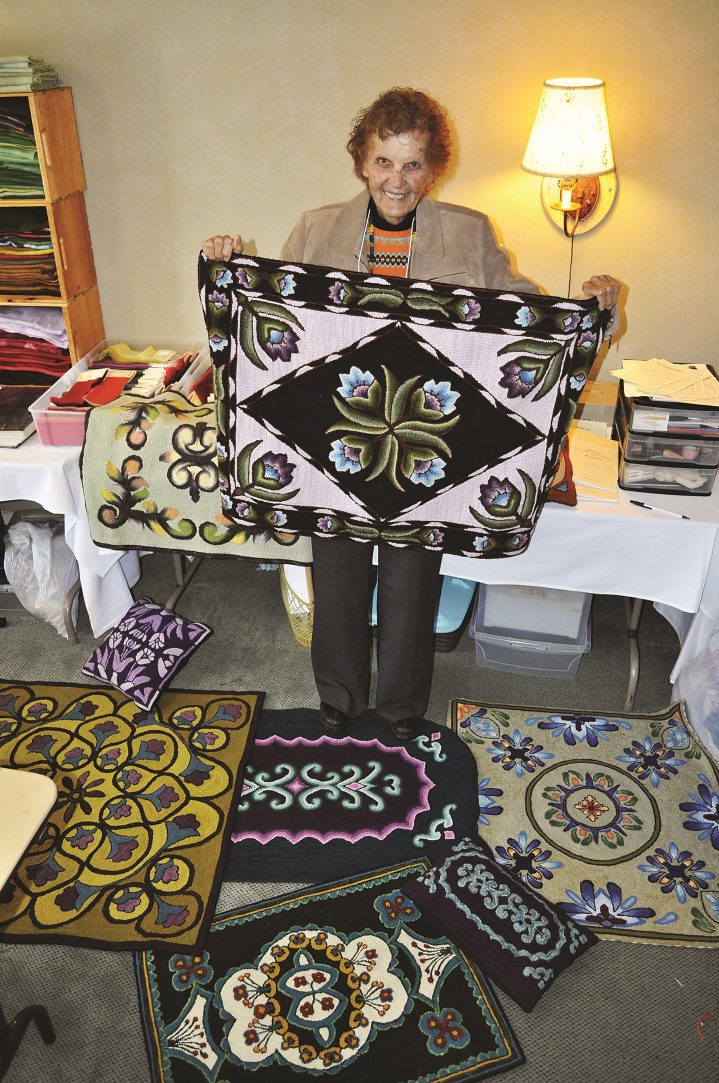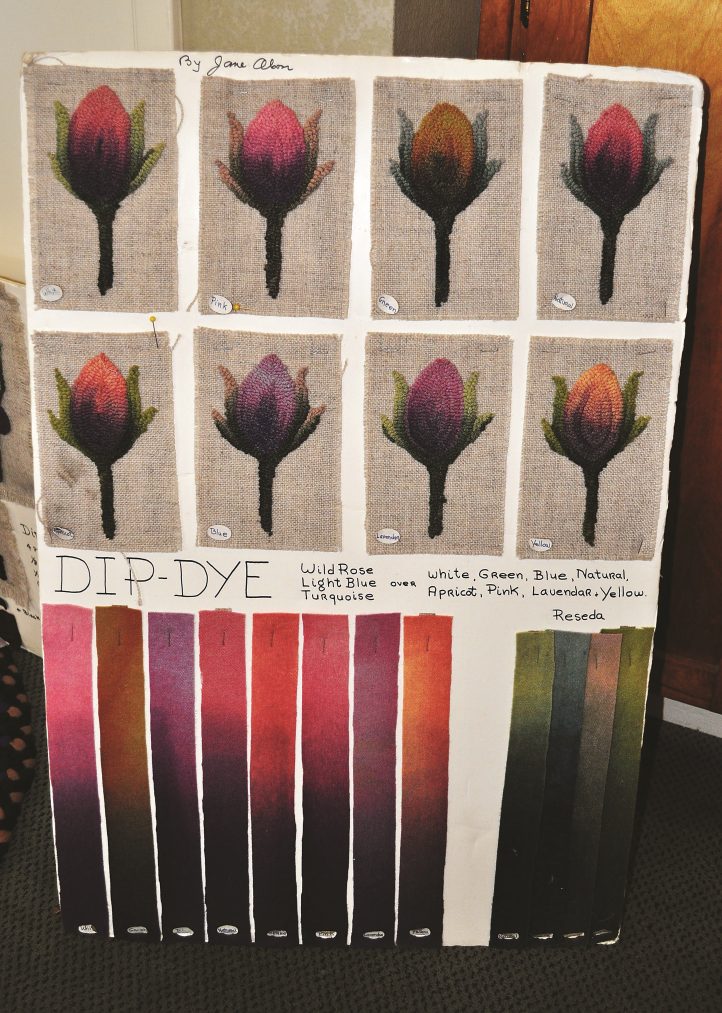
Jane stands proudly amid some of her many creations at the 2011 Cambria Pines Rug Camp.
The rug hooking world was saddened by the death of Jane Olson, an icon in the art of rug hooking and wool dyeing. One of the founders of the art of rug hooking in the western United States, Jane succumbed on August 17, 2011, to the blood disease myelofibrosis, which she had been fighting for several years.
In her final in-depth interview, Jane reflected on the maturation of the art of rug hooking, which she witnessed first-hand over a career that spanned more than seven decades. On June 6, Jane talked with Los Angeles-based freelance writer and photographer Mary Wortman while Jane was teaching rug hooking, braiding, and wool dyeing classes at the annual rug hooking camp at Cambria Pines Lodge in Cambria, California.
Q: When did you start rug hooking?
A: I started as a teenager in the 1930s. My mother was a rug hooker. She was one of Pearl McGown’s original stu-dents. The funny thing about that is that my mother hated to hook backgrounds so she’d toss these rugs at me and tell me to fill in the backgrounds. So when I started hooking, I hooked only backgrounds. To tell you the truth, I hated it as much as my mother did. It was boring. You just pull the loops the same way time after time.
Q: Since teachers weren’t as prevalent when you were starting out, how did you learn to hook anything other than backgrounds?
A: I taught myself. I chose my size, colors, and pattern, then cut my wool in a #3, and just dug in and started. I lived in Massachusetts at that time so wool was plentiful. I bought my first cutter from Dorr in New Hampshire. It cost me $25, and I still have it.
Q: Are you still hooking?
A: Absolutely. Rug hooking takes me to another world. Hooking is an amazing art. I believe it can even make you live longer because it keeps your body and mind calm. It’s soothing. Some women find themselves at a certain point in their lives and seem to have nothing to do but sit and watch television. You can atrophy that way. With rug hooking, you make a lot of decisions as you progress, and that keeps your mind sharp.
Q: How did you enter the teaching aspect of the art?
A: In 1954, I moved to California. At that time, rug hooking hadn’t left the East Coast. Neighbors used to drop in and see me hooking and they’d see the rugs on the floor and ask what I was doing. They asked me to show them how, and I’d tell them to come back on Saturday. That was 57 years ago and I still hold a big class on the first Saturday of every month for about six hours. I also hold half-day classes in my home every Wednesday and Thursday. I’m really interested in people learning the art. Even today, when someone wants to learn but can’t afford to start, I give them the wool and teach them anyway. I’m most interested in people learning. It’s important to keep our art moving forward.
Q: You have such a large color palette. How did you progress from learning McGown’s tight style using dark colors to the free feeling and subtle shading in your pieces today?
A: I started dyeing wool to save money and now I offer customers 75 colors in my mail order business. From my perspective, it’s important to have colors available for everyone. My philosophy of hooking and braiding has to do with freedom. I believe we all should be free to choose our own colors and patterns, and to make our own deci-sions. The McGown school keeps everyone in a box. It tells them what pattern to hook, what colors to use, what size loop to pull. McGown makes all the decisions for you, which is what I have trouble with.
Q: It seems that you have an independent streak in your hooking and teaching. Is that true?
A: Well, some people call it independence; some people call it stubbornness. I just know that I would never be dependent on someone else to make my decisions. Some women love specific colors but won’t use them because their husbands might not like the finished product. I just want to shout at them, “This is yours! It’s an expression of you!”
Q: How does your personal philosophy of teaching the art differ from the McGown school of teaching?
A: For starters, I want people to fall in love with the art. I want people to see if they like hooking so I start them out with a small project. McGown starts people off with a large piece and you have to invest a lot of money and a lot of yourself before you can determine if you even like hooking. You have to be generous with yourself. This is your project. It’s going in your house. It should be a pat-tern that you like in colors that you’re wild about.
Q: How have you seen rug hooking develop from the days of Pearl McGown when the art was more a craft, and a utilitarian one at that, to today where it seems to be more of an art with myriad subtleties?
A: Hooking is now an art. People are creating more wall hangings than rugs today. As an art movement, rug mak-ing is expandable. You can always build on it and take it to the next level. Whether hooking or braiding, more people will make a rug or wall hanging than will pick up a paintbrush and create a painting. My house is full of rugs because I don’t like making things that you can’t use. I guess that’s the New Englander in me. And every piece has a story.

Jane (standing, center) teaches hooking, braiding, and dyeing at the annual Cambria Pines Rug Camp in Cambria, California, June 2011.
Q: How have you personally progressed in both creating and teaching during the past 70 years?
A: In the 1930s, I started by using old clothing and cut-ting strips with scissors. Then in the 1940s, we had cutters that cut a couple of strips at a time. I have taught people how to hook and braid in California, Kansas, Washington, Oregon, Canada, Florida, Texas, and up and down both U.S. coasts. I started hooking primitives just like everyone else but I quickly got tired of flowers and wanted to work on other things. I think the people who continue to work on primitives do so because they want their pieces to be finished quickly. We’re an instant society. That’s also why some people buy rugs instead of making them.
“With rug hooking, you make a lot of decisions as you progress, and that keeps your mind sharp.” – Jane Olson
Q: How much money do you charge for a rug?
A: I’ve never bought or sold a rug in my life. I do give some of them away but only to family members. And I have a stipulation. If they don’t want it anymore, they have to give the rug back to me or give it to another fami-ly member. My rugs can never go outside my family.
Q: Have you ever been offered money for a rug?
A: I was once offered one million dollars for one of my rugs. In the 1980s, I was teaching classes in Canada and I had a rug hanging up with an image of a famous clipper ship called the Flying Cloud. The real ship was built in 1853. A fellow wanted to buy it and told me to name my price. When I told him that there was no amount of money that could make me part with it, he offered me one million dollars. When I said no for the fifth or sixth time, he couldn’t believe it. The last I saw of him was when he was walking away shaking his head.

Jane Olson’s hand-dyed display illustrates shading techniques and coloring subtleties of various shades of rose.
Q: After all the years you’ve been hooking and teaching, do you find anything difficult to execute?
A: Water is the hardest thing to do because you have to put in so many color changes and you have to give water the effect of movement. One of the many wonderful things about hooking art is that small additions can make big differences. Inserting one strip can add that certain
“thing” that works just perfectly in a specific spot.
Q: Where do you see rug hooking going in the future?
A: I believe that the ability for the art to continue to change will depend on how much people continue to value handwork. The possibilities of where it goes in the future are without limit.
Q: If you could have one wish for the art what would it be?
A: I need two wishes! The first one is that our teachers continue to teach, and for their students to teach others, and keep passing on the knowledge. We who love rug hooking are duty bound to ignite that passion in others. My final wish is for it to go on forever.
Jane Olson . . .
. . . TEACHER: Jane became a teacher by accident. In 1965, she took a rug hooking class as part of a local community education program. When the instructor resigned, she asked Jane to take over teaching. She fell in love with her students and with teaching.
. . . TRAVELING TEACHER: Jane is renowned for spreading the rug hooking art throughout the western United States and Canada.
Renowned rug hooker Jan Winter (who has been featured in Celebration) began a rug hooking camp in Cambria, California, in 1997. At the time, there was only one rug hooking camp in California and it was a McGown camp. “I wanted to have an open camp where people could work on any pattern they want-ed,” said Winter. “Since Jane Olson’s classes around the country and at her studio were always sold out, I wanted more people to have access to her talent. She taught at Cambria every year since it opened—the only teacher who has done so.”
. . . BUSINESS OWNER: Jane purchased Mildred Sprout’s business in 1970, and a few years later purchased McClain’s swatch enterprise. It was then that Jane began dyeing wool for her customers. She offered the full spectrum of talents—teacher, mentor, colorist, designer, and friend.
. . . MENTOR: Jane gave to all in need, whether it was advice, instruction, or even wool when the artist need-ed financial assistance. She used to whisper to her stu-dents as she surreptitiously plopped wool down over their shoulder onto their frame, “Pay me back when you can.”
